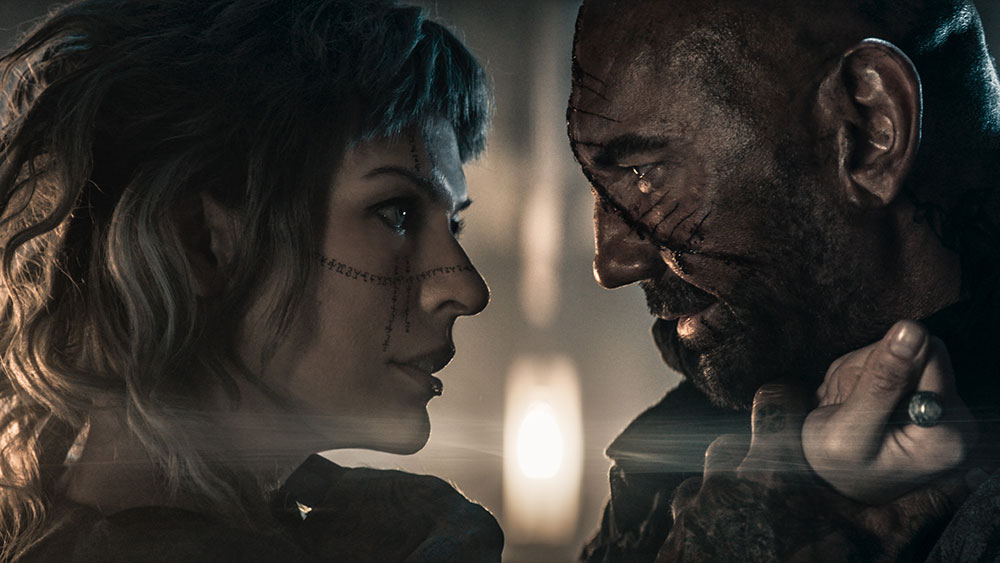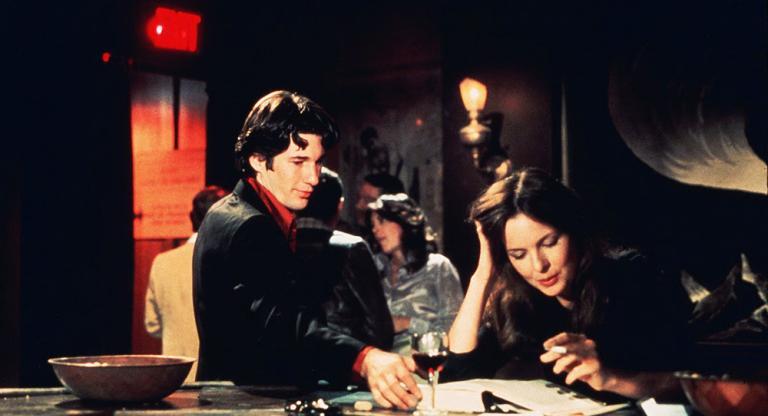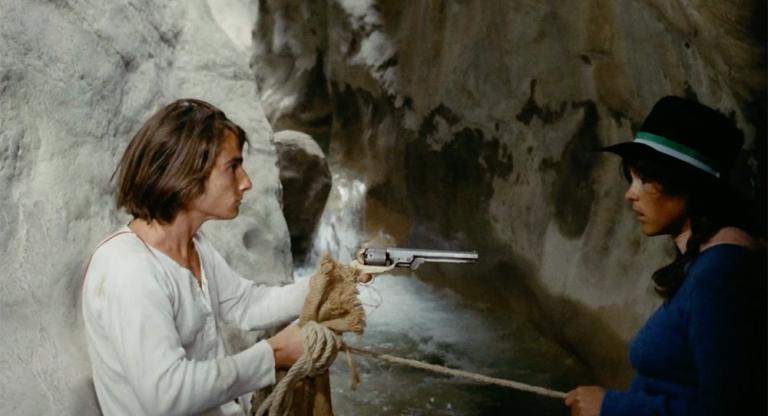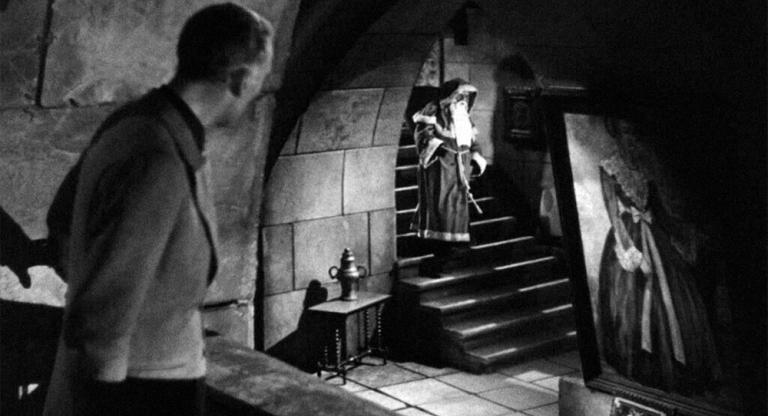In the Lost Lands is the seventh collaboration between the apocalyptically-inclined husband and wife and director-star duo Paul W.S. Anderson and Milla Jovovich. They met on Resident Evil (2002), constructing innovative ways to decapitate the drooling zombies created by a sadistic multinational conglomerate. Over the course of its brain-spattered six-film franchise run, they become pulp poets laureate of civilizational collapse, working through sci-fi, horror, and monster movie templates to depict the flailing end of humanity.
In the Lost Lands is their first attempt at fantasy, adapting an early George R.R. Martin short story in which a cursed sorceress named Gray Alys (Jovovich) is obligated to grant every wish presented to her, no matter what doom she might foresee. Her latest granted wish requires her to steal the soul of a werewolf, a mission for which she hires the help of Boyce (Dave Bautista), a Western-style gunslinger and feared hunter. Of course, it takes place in a world ravaged by environmental catastrophe, the remnants of humanity cowed by fundamentalist freaks and a demented, self-destructive royal family.
I spoke with director Paul W.S. Anderson about the film’s very metal set design, his obsession with cities gone to seed, and his innovative, painterly approach to visual effects.
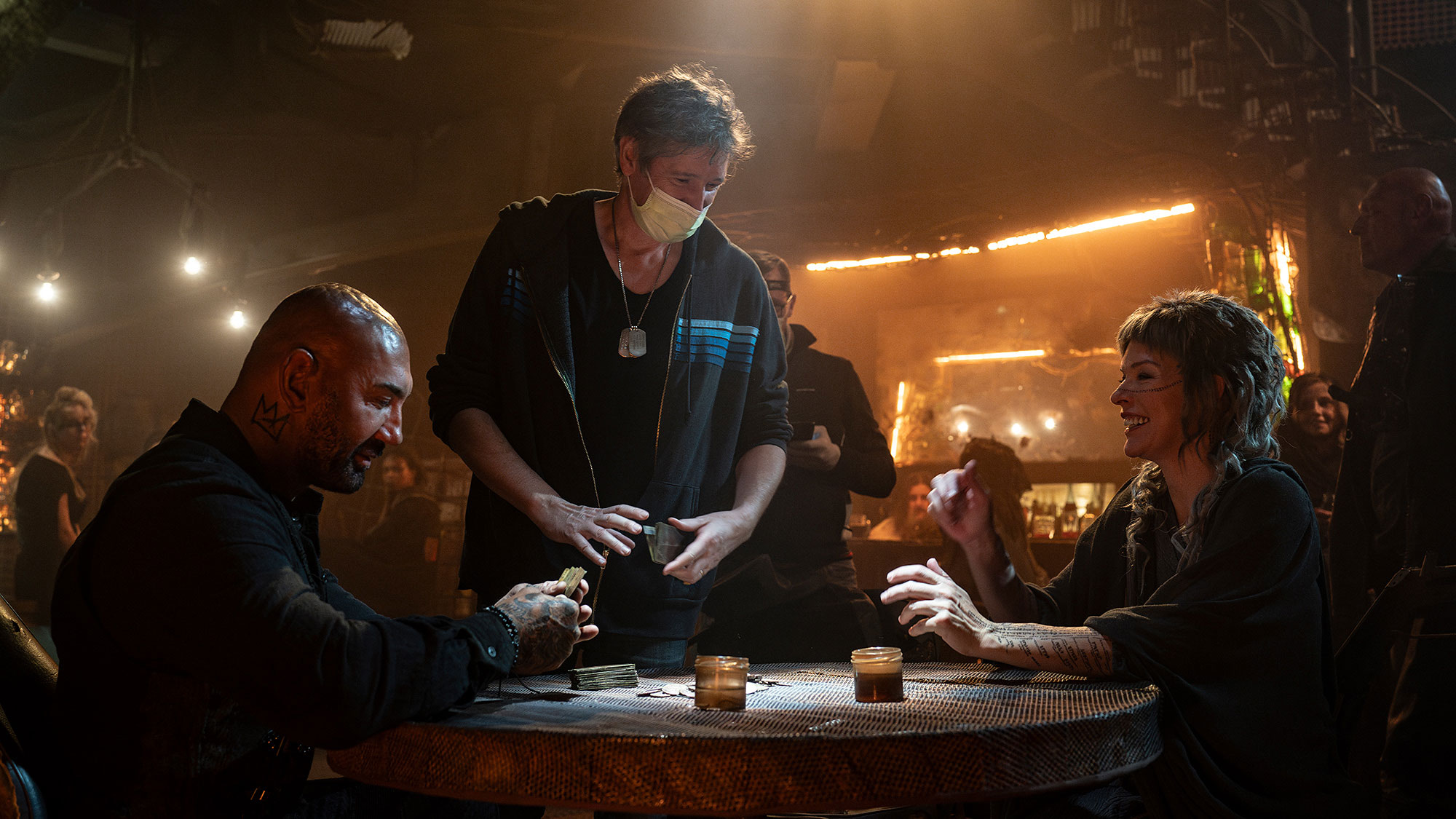
R. Emmet Sweeney: How did you first hear of this lesser-known short story by George R. R. Martin, first published in 1982?
Paul W.S. Anderson: I heard about George from Mila because she's a huge consumer of fantasy. She is a big George fan and has read all of his books. She was very aware of George, and then she was approached by my co-producer and writer Constantin Werner, who had the rights to three of George's short stories. It was In the Lost Lands, The Lonely Songs of Laren Dorr, and Bitterblooms. Mila said, “Oh my God, it's George. You should talk to Constantin Werner about this, we should get involved.” That was really my inception point.
RES: Since Milla was such a fan, how involved was she in the pre-production process?
PWSA: She was totally involved. She put myself and Constantin together, and then we developed. She read every draft of the screenplay and gave extensive notes. She was very much a defender of George's work. We all felt that what was great about the story was that it had these wonderfully dark characters, and that the heart of the story was really the relationship between Gray Alys and Boyce. As we were building out the short story—adding action, adding antagonists, adding more incidents—Mila was very much a champion of the focus of the movie remaining on the relationship between these two characters. Although she's been performing as a producer on a lot of the movies I've made, this is the first time she's actually stepped forward and taken a full producer credit, which she completely and utterly deserves, because she shepherded this project for seven years.
RES: In the Lost Lands pulls together a lot of elements from your previous work, like Ray Harryhausen-esque skeletons in Mortal Kombat [1995], the apocalyptic horror of Resident Evil…
PWSA: The inception point was always a fantasy story. I'd never done a fantasy story before, and Mila had never played a fantasy character. She’s played some pretty superhuman characters, but they've always been kind of man-made constructs. Think about The Fifth Element [1997], made in a machine; Resident Evil, the product of cloning and the Umbrella Corporation, and viruses and anti-viruses. So, she was very much into telling a story that at its heart was a fantasy story. For me, the attraction was that I saw it as a dark adult fairy tale, with at its core, the message of “Be careful what you wish for.”
I felt like George had told that story in a very adult way. That really appealed to me because I've always been a fan of fairy tales—and the original fairy tales as well, not the Disneyfication of these stories, but the original Brothers Grimm and the original Hans Christian Anderson, where the Little Mermaid dies at the end. These fairy tales had a very dark heart to them. We built it out and turned it into a movie. What you end up with is a pretty unique mix of George's amazing characters and his amazing original adult fairy tale fantasy with an overlay of my interests. It’s very much a collision of our two worlds.
RES: There are adult characters that actually have sex, which you don't see too much in big Hollywood productions anymore.
PWSA: It was George, so it was always going to be R-rated and dark.
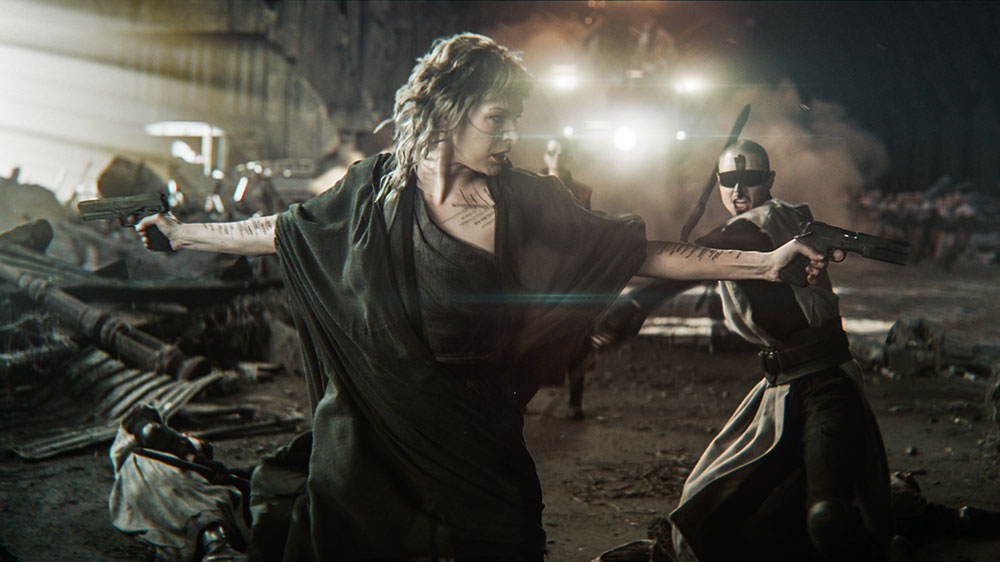
RES: I really loved the production design, it reminded me a lot of Frank Frazetta illustrations…
PWSA: It was Frank Frazetta, Heavy Metal magazine… Yeah, that was what I consumed massively when I was a younger man. Because it was an adult fairy tale, it required a pretty original setting and an original approach to production design, which is why we made it look the way it looked.
We really embraced the painterly feel of the imagery, which harks back to a lot of those graphic novels that you were mentioning, and a lot of those artists from the ‘70s, but also further back. When I was talking with the team making the movie, my touchstone was that it should be the graphic novel that Hieronymus Bosch never wrote; it should have that very kind of textured, dark feel to it. That’s something I'm very proud about. If you freeze on them, there’s an awful lot of detail in the images. They are kind of like graphic novel frames come to life, or like medieval paintings come to life, which is appropriate because with the whole setting, although it is post-apocalyptic and futuristic, you have a society that has fallen back into this feudal state.
RES: How did you make the painterly feel work visually? I know you used a lot of blue screen, but I read that you created all the backgrounds before shooting to help your DP match the lighting?
PWSA: The movie exists in a stylized reality. We’re not pretending to be 100% photo real—the actors are definitely baked into those backgrounds and exist in those environments. I think one of the problems with a lot of blue screen photography is that quite often the environments are not built. The blue screen has this kind of generic blue screen lighting, which, when combined with dramatic backgrounds in post-productions, makes the actors never really feel like they fit in the backgrounds. We had a different approach. We built all of the backgrounds before we started principal photography and had real-time rendering and playback so that the virtual camera, and the real camera, were slaved together. So, when you move the real camera, the virtual backgrounds move as well. The actors could see the environments they were in, and the camera operators could see what the environments looked like and frame appropriately. The DP could light appropriately as well. A good example of that is Dave's introduction—that opening gunfight scene where he's very, very silhouette-y, and it's very, very striking. There is no detail in that image. He's a total silhouette, apart from the band of light across his eyes. We were able to achieve that because we knew exactly how the foreground and the background would marry together. The DP would be able to look at the sun in the virtual world—which was all provided by Unreal Engine—and go, “It looks really good with the sun 15 degrees above the horizon line. Let's put the light 15 degrees above the studio floor, and then the two environments match together perfectly.
It was really, really helpful for the actors. I mean, both Dave and Milla came up to me and said, “This is incredibly helpful,” because they both have great imaginations, and they've both worked on big science fiction projects before. They’re both used to standing in front of a blue screen and acting towards a tennis ball, right? But being able to see the imagery on the day was incredibly helpful to them.
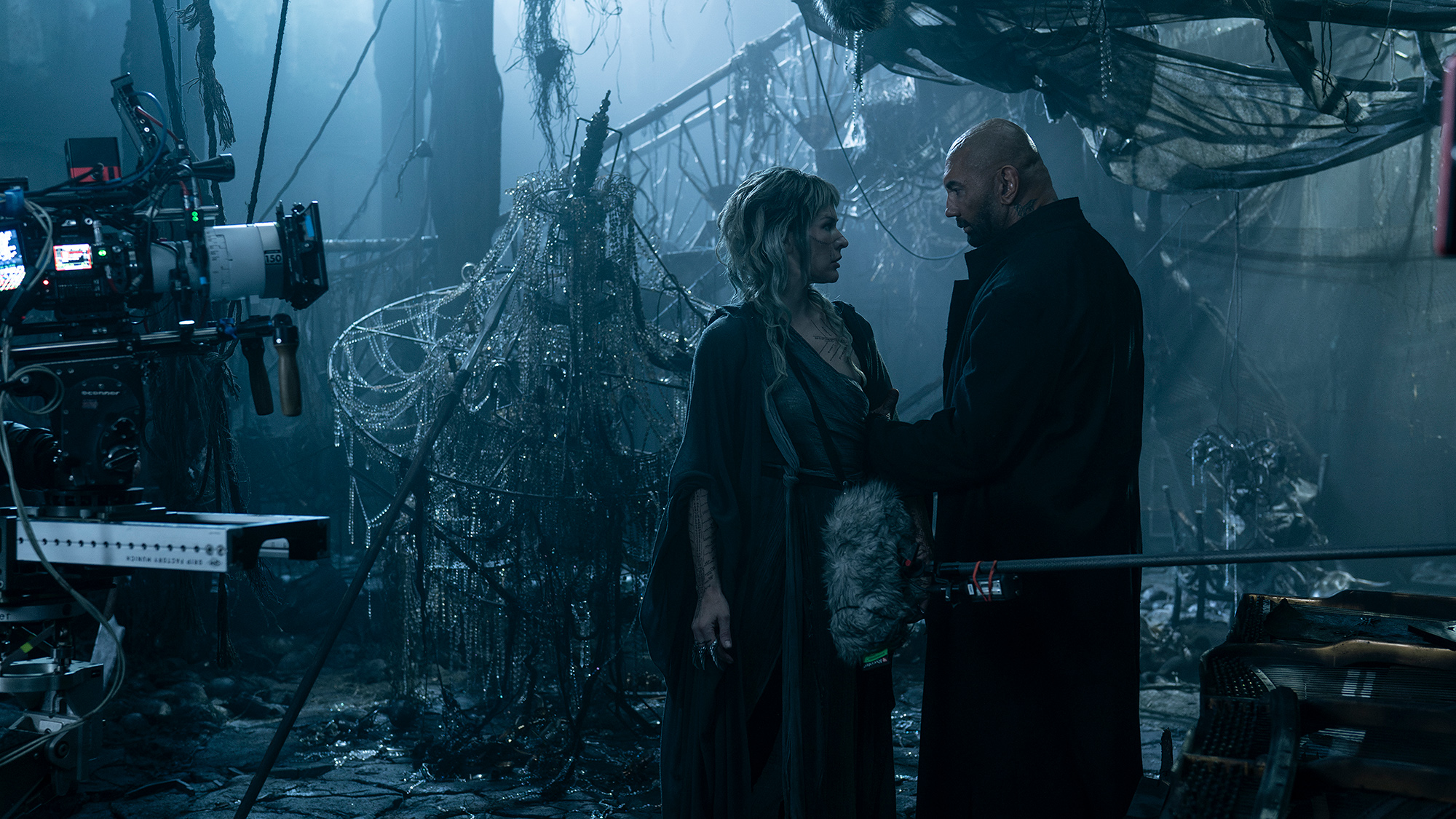
RES: You mentioned your regular Director of Photography Glen MacPherson. Can you talk about your long-time collaborators and why you keep returning to work with them?
PWSA: I've done seven movies with Glen. He's a very adaptable DP. I think DPs get kind of typecast, a bit like actors. They do one movie that looks a certain way, and everyone goes, “Oh, well, that's their look.” And of course, a great DP can pretty much do whatever you want. You just have to direct them. One of the things I love about working with Glenn is that the movies we do have completely different looks. Resident Evil: Afterlife [2010], Resident Evil: The Final Chapter [2016], and Resident Evil: Retribution [2012]. And Monster Hunter [2020] looks very different to Resident Evil, and Lost Lands looks very, very different to Monster Hunter.
RES: Yeah, I mean, Peter Deming shot both Mulholland Drive [2001] and Austin Powers [1997]…
PWSA: It’s exciting for a director of photography to get to explore these different things as well, rather than just getting stuck with one genre and one look. And, I do like coming back to working with the same people, because the movies I make are not small. I take a DP with me and a visual effects supervisor, and those tend to be the same people, but everybody else is different. So, in a crew of 150 people, 148 of them are complete strangers at the start of the movie. Only two of them are the same. It’s important for me to have that, because there is a lot of change, and because we work with a lot of local crews all over the world—in South Africa, in Poland, in Mexico, in Canada. It's important to have the one or two people that don't change and are good at executing my vision.
RES: There are some gnarly werewolf transformation scenes in this one—how would you place it in the history of cinematic werewolves? Did you know there was another werewolf movie coming out around the same time?
PWSA: It's so funny that there's just been a werewolf movie that Universal released. You wait 20 years for a werewolf movie and then suddenly, like a bus, two of them come along at the same time. No one had done transformation scenes in a long time and I decided that I didn't want to go all practical, because the movie has such a painterly feel to it. I felt that going practical, having all the stretching latex and everything, wouldn't really fit with the look of the film. So, we went for something that was more stylized—a visceral feel. You feel the pain in the transformation. You feel the pain of the transformation.
We also looked at animals that have patterns on their fur. If you shave a black-and-white dog, it has the same black-and-white spots on its skin. The coloration of the skin is the same as the coloration of the fur. So, we built a werewolf from the human being that the werewolf was based on with all of the coloration that the original human had. Then, we went into a lot of detail in terms of scanning the original actor so that we could have a lot of the original facial detail and facial performance as well. I think that's what's great about the werewolf, that we got a really great performance out of the actor playing the werewolf.
RES: What is your working relationship like with visual effects director Dennis Berardi?
PWSA: I work with Dennis Berardi, who's based out of Toronto, Canada, and he has pretty much done all of my movies since the second Resident Evil film. For the last 24 years, we've worked together. He used to run a company called Mr. X and now runs a company called Herne Hill Media, which he owns.
When I work with him, I know I'm going to get his best animators, because I get his personal focus. He runs a whole company, but there are two filmmakers that he'll actually be the visual effects supervisor for, come on to set, and be involved with on a day-to-day basis. That’s me and Guillermo del Toro. He’s finishing up Del Toro’s Frankenstein at the moment. So, it's kind of like if the CEO of ILM came to be on set with you. It means you get great focus and great creative input. The problem with a lot of really big visual effects companies is that you never know who's doing your animation. You know they have an A-team, a B-team, a C-team and a D-team. If Spielberg is in the house, he's got the A-team and Jim Cameron's got the B-team. Quite often, your animator is someone who was making tea a few weeks ago.
I've worked with the same team of people—pretty much the same faces—for the last 20 years. Sometimes the buildings where they do their Zoom calls from change and the rooms they're in change, but the people don't. That’s really important to me, because I work with a team of maybe 150 on the shooting crew. And, there’s 150 animators and compositors working on the movie as well. In post-production or visual effects, you have a whole different crew and, as a director, it's just as important to motivate and work creatively with that crew as it is the shooting crew. You have to show up at work every day as a director and do your job, and give people guidance and direction. You don't just hand it over to a visual effects house and wait for them to do the visual effects. I mean, you can do that, but that's not how I choose to work.
RES: Yeah, I think there are plenty of examples where things go haywire without that oversight…
PWSA: Well, I kind of jumped in when I did Mortal Kombat, because to get that job, I totally lied about my experience with visual effects. I knew absolutely nothing about visual effects. When I got the job, I was like, “Oh, damn, I've got to live up to all of my boasting about knowing everything about visual effects.” So, I ended up going into visual effects houses to learn about everything. Having done that, I realized how rare that is. Very few directors do that: actually go into the houses and work with the animators in person. But once I had done it, I was hooked. People enjoyed having me there and I enjoyed having the input. That was my path, so now I can't take post-production easy. You know, there's no lazing around in the cutting room, drinking cappuccinos. I spend half of my time animating werewolves, or helping, you know? I'm no good as an animator myself, but I can offer a bit of constructive criticism.
RES: That definitely shows up on-screen. I mean, there are many, many big Hollywood productions where you can tell the effects are rushed and they show up looking half-finished. The attention to detail in your films really comes through.
PWSA: Thank you. On this movie, I'm pretty proud that we didn't spend the hundreds of millions of dollars that a lot of other big visual effects films do, and to stretch the money, the dollar, we didn't do any overtime. The animators weren't working these punishing 18 hour days, seven days a week that you read a lot about. They had a life, and that's beneficial for them, but it’s also beneficial for me as a filmmaker, because just like with shooting crews, you can work people massive overtime and long hours. But after a 10-hour work day, people start slowing down and you're not getting the best out of them. It doesn't matter whether they're standing on set holding a light, or whether they're working in a post-production company animating something. After being chained to their computer for a while, people start slowing down, and you don't get the best, most creative work out of them. So, we took a little longer in post-production on this movie and allowed people, I felt, to deliver their best work, by actually giving them a weekend off and allowing them to go home and see their kids.
RES: Yeah. I mean, that's just a human thing to do, and you get better work out of it. It seems to work out on both ends there.
PWSA: Exactly. It's good all around.
RES: You keep coming back to these post-apocalyptic scenarios in your films. Do you know what attracts you to them?
PWSA: I don't know. I mean, I grew up in the north of England, which was a fairly bleak post-industrial landscape. When I was growing up, there was a lot of dereliction. It was a big heavy industrial part of England: iron and steel, coal mining, ship building. But when I was a kid, all of that industry and infrastructure had fallen apart. I'm also from a family of coal miners, so that partly explains my fascination with underground spaces and tunnels, and these malevolent environments.
RES: There are a lot of belching smokestacks in In the Lost Lands…
PWSA: Yes, so there's a lot of my childhood, I guess, built into it. But then, what I also love about science fiction and fantasy is that it is kind of a truism. Nothing tells you more about the present-day than science fiction. It allows you to explore present-day concerns, and the world that we live in, in a freer way because you're in these inverted commas. That's what I liked about George's story. On the one hand, it's a fantasy story, but on the other hand, be careful what you wish for is something that everyone can learn from right now.
RES: Yeah be careful who you vote for, right? Another apocalyptic element to the film is the score by Paul Haslinger, former member of Tangerine Dream.
PWSA: Haslinger is amazing. He's the composer I've worked with the most and what I really like about him is that he's very adaptable. He’s the Glen McPherson of music. On the one hand, there's the crunchy guitars and techno of Death Race [2008]. And then, I immediately did The Three Musketeers [2011] with him, which is completely different. It's more orchestral and lush, and has lots of tangos in it. He’s also been a great collaborator on the Resident Evil movies. You would think it's a different composer, even though it's the same man. And growing up, I was a huge fan of Tangerine Dream. I found their music very evocative. When I was starting as a writer, I would play Tangerine Dream and write.
I felt like a lot of music scores, especially for Hollywood movies, have become very generic. It’s this kind of sub Hans Zimmer bombast, where it's synths and orchestra working together. It was very original when Hans Zimmer started doing it, but I feel like in a lot of these big movies the scores sound almost interchangeable. I wanted something that was a real callback to the scores that were made by machines and humans; I wanted to go back to scores that I'd loved from the 1980s, that Tangerine Dream had written back when Paul was a member of Tangerine Dream.
We listened to scores like Miracle Mile [1988], Sorcerer [1977], a lot of Near Dark [1997]. “The reason those scores are so distinctive,” Paul said, “is because we use technology, but the technology was very flawed.” The computers weren't good enough to keep time, and over time, over a five-minute track, the time signature would keep slipping because the computer wasn't on it. And I thought, “How do you recreate that?” He said, “Well, you can't, because that was a facet of that technology at the time. There's no kind of plug-in that exists to do that.” It was unique, it felt like machine music, but it had a human element to it, because the machines made mistakes.
Paul ended up contacting Peter Baumann, who was also in Tangerine Dream, and who had kept a lot of these 1980s synthesizers. We used one for some of the tracks on the score. We had a mini Tangerine Dream reunion where Peter came in and played, and we got these unique looping Tangerine Dream synthesizer sounds. They sound like the original ‘80s scores because they were made using that original technology, which I was quite excited about.
RES: Do you have time to play any video games these days?
PWSA: Well, I've partnered with Sega to do an adaptation of The House of the Dead, which is a particular favorite of mine. So, I will be shooting a lot of unpleasant things in the near future. That’s my current obsession right now.
